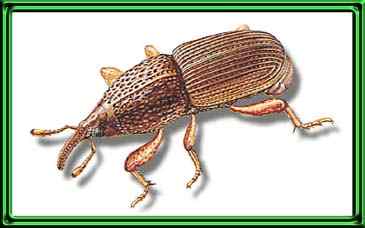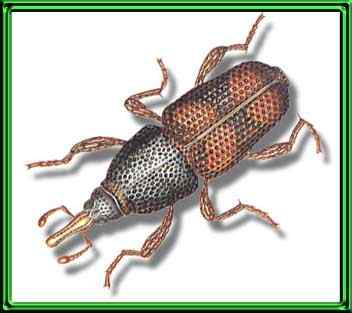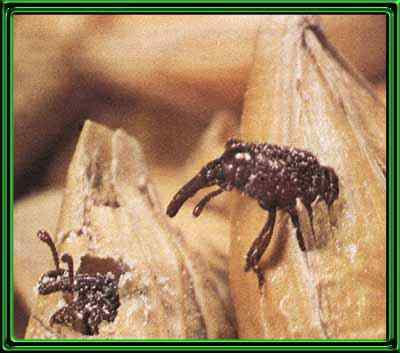
Sitophilus
granarius
(Grain Weevil)
(Grain Weevil)

Sitophilus
oryzae
(Rice Weevil)
(Rice Weevil)
These insects are easily recognisable by their elongated snouts (this is known as their rostrum). Weevils are also the bane of a gardeners life as well, so they get everywhere. They are the commonest pest in stored grain. The Grain Weevil cannot fly but is a tireless walker (should live in the Lake District).They are usually found in grain storage facilities or processing plants, infesting wheat, oats, rye, barley, rice, and corn. Although not often found in the home, sometimes they infest table beans, acorns, chestnuts, birdseed, sunflower seeds, and ornamental corn. They are rarely found in macaroni and spaghetti (must have a thing about Italian food).
Identification:
Both weevils have chewing mouthparts at the end of their snouts or prolonged heads, and are about 1/8- to 3/16-inch long, depending on the size of the grain kernel. In small grains, such as millet or milo maize, weevils are small in size; they are larger in corn. The adult granary weevil is a shiny reddish-brown with elongated pits on the thorax, whereas the adult rice weevil is a dull reddish-brown with round or irregularly shaped pits on the thorax and four light spots on the wing covers. These deep round punctures and light spots are lacking on the granary weevil. Also, the granary weevil cannot fly, whereas the rice weevil can fly. Both weevils in the larval stage are legless, humpbacked, white to creamy white, with a small, tan head. Weevils in the pupa stage have snouts like the adults.
Lifecycle:
The egg, larva, and pupa stages of both weevils occur in the grain kernels and are rarely seen. Feeding is done within the grain kernel, and adults cut exit holes to emerge. Emergence holes of the granary weevil are larger than those of the rice weevil, and tend to be more ragged than smooth and round. Females drill a tiny hole in the grain kernel, deposit an egg in the cavity, then plug the hole with a gelatinous secretion. The egg hatches into a young larva which bores toward the center of the kernel, feeds, grows, and pupates there. New adults bore emergence holes from the inside, then leave to mate and begin a new generation. See the picture below of weevils as they emerge.

Female grain weevils lay from 36 to 254 eggs at a rate of 2-3 a day. At 80 to 86°F, 75 to 90% relative humidity, eggs hatch in wheat with a moisture content of 13.5 to 19.6% in 3 days. Larvae mature in 18 days, and the pupa in 6 days. The life cycle is about 30 to 40 days during the summer, and 123 to 148 days during the winter, depending on temperature. Adults live 7 to 8 months. Female rice weevils lay between 300 to 400 eggs, with the life cycle requiring about 32 days for completion. Rice weevil adults live 3 to 6 months, infesting grain in the field, especially in the tropics and sub-tropics, in fact it is one of the most serious pests. Two larvae can develop in one wheat kernel, but only one larva of the granary weevil can develop per wheat kernel. Both granary and rice weevils feign death by drawing up their legs close to the body, falling, and remaining silent when disturbed.
Again the treatment is the same for all stored product insects: